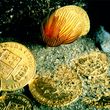Others
The Orient
On August 1st 1798 the French fleet of General Napoleon Bonaparte, which was anchored off the coast of Egypt, was taken by surprise by the British fleet commanded by Admiral Nelson. A dramatic battle at close quarters took place that is today known as the Battle of the Nile. An initial survey and excavation of the remains of the French fleet were initiated by Jacques Dumas in 1983 and resumed 13 years after his death by Franck Goddio in cooperation with the Egyptian Supreme Council of Antiquities.
The most important results of Franck Goddio’s work are detailed underwater maps of Aboukir Bay that allow a reconstruction of the order of events of the battle as well as showing the positions of the ships and the tactics of the two camps. Extensive electronic survey, followed up by hundreds of dives by underwater archaeologists, provided information for these maps.
Alongside Napoleon’s flagship, the Orient, with 2700 gross registered tons and 120 cannons - the biggest ship of the fleet - the French frigates the Serieuse and the Artemise were also discovered. The Serieuse, the smallest ship of the fleet, sank during a desperate attempt to keep the British fleet away from the French. Outgunned, the crew of the Artemise, abandoned ship and set her on fire to prevent the British from capturing her. The Orient later exploded at the height of the battle.
Surprising new evidence has come to light regarding the demise of the Orient, which was pieced together from a painstaking analysis of the remains of the vessel and the way that they were spread over an area of half a square kilometre. Study of the pattern of scattered artefacts, as well as of the remains of the hull, have led Franck Goddio to the conclusion that the huge ship was not, as formerly assumed, destroyed by one, but by two explosions that detonated almost simultaneously.
Seven anchors from different ships of the fleet, which were found around the remains of the Orient give detailed information about the position of some of the French ships in the line of battle. These vessels cut their cables and abandoned their anchors to set themselves free so as not to be destroyed by the inevitable explosion of the burning Orient. As well as cannons, portable firearms and ammunition, several everyday objects were also found. They provide information about ordinary daily life on board for the ships’ crews. Parts of human skeletons were also exhumed. Among the most spectacular finds are thousands of lead typefaces that belonged to a printing press on board the Orient. Bonaparte had taken the press with him on campaign to spread his messages most effectively.
A large amount of French gold, silver and copper coins were found, some of them dating back to the era of Louis XIV, some to Louis XV and most of them to the era of Louis XVI. Most surprisingly, there were also gold coins from Malta, the Ottoman Empire, Venice, Spain and Portugal. This leads to the suggestion that these more unexpected coins were part of the Maltese Treasure that Bonaparte captured on his way to Egypt.
Click here for publications





















